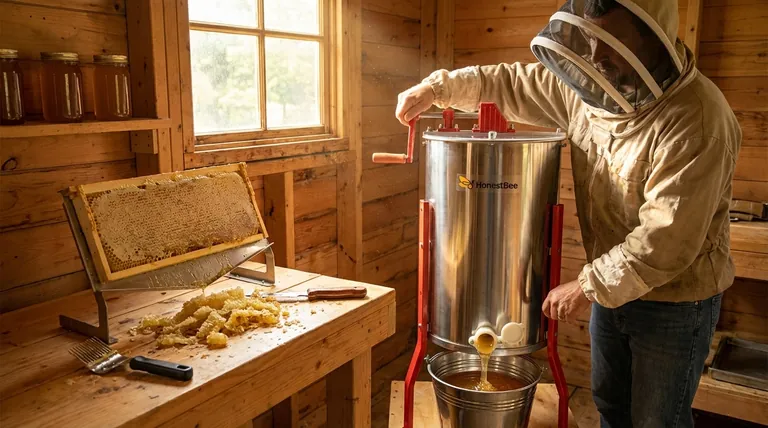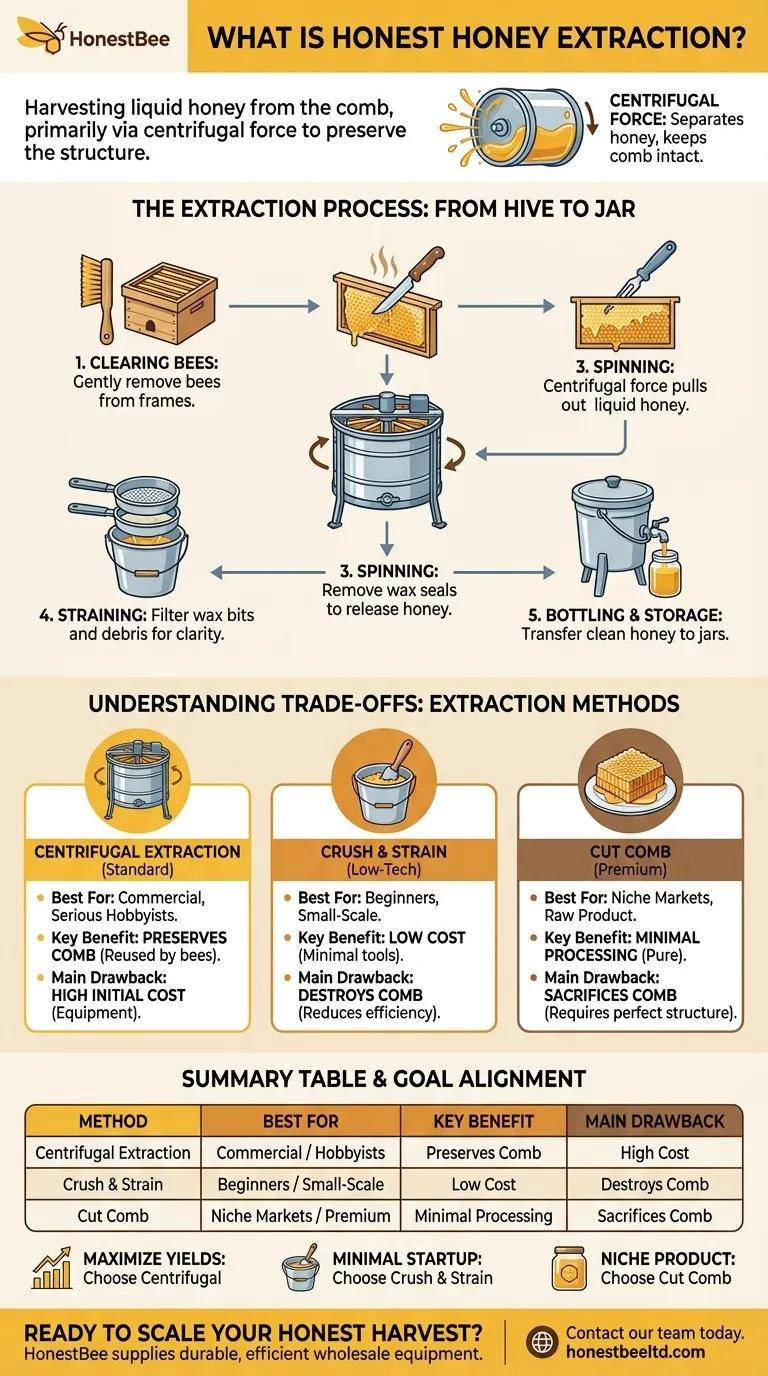Honey extraction is the process by which beekeepers harvest liquid honey from the honeycomb. Bees create and cap honeycomb with wax to store honey as their winter food supply, and extraction is the mechanical procedure for removing it from these sealed wax cells, typically while preserving the comb for the bees to reuse.
The core principle of modern honey extraction is using centrifugal force to separate honey from the wax comb. This method is highly efficient and, most importantly, keeps the delicate comb structure intact, saving the bees immense energy they would otherwise spend rebuilding it.

The Extraction Process: From Hive to Jar
Successfully extracting honey involves a series of sequential steps, each requiring specific tools and techniques to ensure a clean harvest and maintain the health of the colony.
Step 1: Clearing Bees from the Frames
Before honey can be brought indoors for extraction, the bees must be gently removed from the honey-filled frames, known as "supers." This is typically done using a soft bee brush to sweep them off or an escape board, a one-way door that allows bees to leave the super but not re-enter.
Step 2: Uncapping the Honeycomb
Bees seal each cell of honey with a pristine wax capping. To release the honey, these cappings must be removed. This is called uncapping.
Beekeepers use specialized tools like a hot knife, which melts through the cappings, or a serrated cold knife. An uncapping fork or scratcher is also used to pierce any missed cells, ensuring all honey can be extracted. The wax cappings are collected in a separate bin.
Step 3: Spinning with a Centrifugal Extractor
This is the heart of the process. The uncapped frames are placed inside a honey extractor, a large drum that spins the frames at high speed.
The centrifugal force pulls the liquid honey out of the cells and onto the inner wall of the extractor. The honey then runs down the wall and collects at the bottom.
Step 4: Straining and Clarifying
The raw honey collected from the extractor contains small bits of wax and other hive debris. It must be filtered before bottling.
The honey is typically run through a double sieve or a series of finer filters to remove these particles. This results in the clear, clean honey you expect to see in a jar.
Step 5: Bottling and Storage
Finally, the strained honey is transferred to a bottling bucket, which is a food-grade container fitted with a spigot or "honey gate" at the bottom. This gate allows for easy, mess-free filling of jars for storage, sale, or personal use.
Understanding the Trade-offs: Extraction Methods
While centrifugal extraction is the standard for most beekeepers, it is not the only option. The method you choose involves distinct trade-offs in cost, labor, and impact on the bees.
The Standard: Centrifugal Extraction
This method, detailed above, is favored by beekeepers with more than a few hives.
- Benefit: Its greatest advantage is that it preserves the wax comb. Since bees expend significant energy to produce wax, returning the empty combs to them drastically increases the hive's potential honey production for the next season.
- Drawback: The primary downside is the initial investment. A honey extractor can be one of the most expensive pieces of beekeeping equipment.
The Low-Tech Alternative: Crush and Strain
This is the oldest and simplest method of extraction, requiring minimal equipment.
- Benefit: It is extremely low-cost, making it accessible for a new beekeeper with only one or two hives. The only required tools are a bucket, a tool for crushing, and a filter.
- Drawback: This method destroys the honeycomb. The entire comb is crushed to release the honey, forcing the bees to completely rebuild it from scratch. This significantly reduces the hive's efficiency and future honey output.
The Premium Product: Cut Comb
This method involves cutting sections of the capped honeycomb directly from the frame and packaging them as-is.
- Benefit: It requires very little processing and results in a premium, raw product that is highly valued by consumers.
- Drawback: Like crush and strain, it sacrifices the comb. It also requires the bees to have built a perfect, straight comb suitable for cutting.
Making the Right Choice for Your Goal
Your approach to extraction should align with your beekeeping philosophy and the scale of your operation.
- If your primary focus is long-term hive productivity and maximizing honey yields: Invest in a centrifugal extractor to preserve the bees' valuable comb.
- If your primary focus is processing honey from a single hive with minimal startup cost: The crush and strain method is a perfectly viable starting point.
- If your primary focus is creating a high-value, natural product for a niche market: Preparing and selling cut comb is an excellent way to showcase honey in its purest form.
Ultimately, understanding these methods empowers you to choose the process that best supports the health of your bees and achieves your personal goals.
Summary Table:
| Method | Best For | Key Benefit | Main Drawback |
|---|---|---|---|
| Centrifugal Extraction | Commercial apiaries, serious hobbyists | Preserves wax comb for bees to reuse | High initial equipment cost |
| Crush and Strain | Beginners, small-scale beekeepers | Low cost, minimal equipment needed | Destroys honeycomb, reduces hive efficiency |
| Cut Comb | Niche markets, premium product sales | Minimal processing, raw honey appeal | Sacrifices comb, requires perfect comb structure |
Ready to Scale Your Honey Harvest?
Whether you're a commercial apiary looking to maximize yields or a distributor seeking reliable equipment, HONESTBEE has the wholesale solutions for you. We supply durable, efficient honey extraction equipment—from extractors and uncapping tools to straining systems—designed to support healthy hives and streamline your operation.
Contact our team today to discuss your needs and explore our full range of beekeeping supplies.
Visual Guide

Related Products
- 2 Frame Stainless Steel Manual Honey Spinner Extractor for Beekeeping
- 6 Frame Manual Stainless Steel Honey Extractor Beekeeping Equipment
- Electric 8 Frame Honey Spinner Extractor Equipment for Beekeeping
- HONESTBEE 8 Frame Electric and Manual Three Use Honey Extractor
- 8-Frame Electric Self-Reversing Honey Extractor Spinner for Commercial Honey Extraction Equipment
People Also Ask
- How does centrifugation work in honey extraction? The Sustainable Method for Modern Beekeepers
- What are the advantages of tangential honey extractors? Gentle, Affordable Honey Extraction for Your Apiary
- How often should a honey extractor be cleaned if used multiple times a year? Optimize Your Harvest Workflow
- What are some expert tips for cleaning a honey extractor? Protect Your Harvest & Equipment
- Can a manual extractor be upgraded to an electric one? Save Labor & Boost Efficiency



















